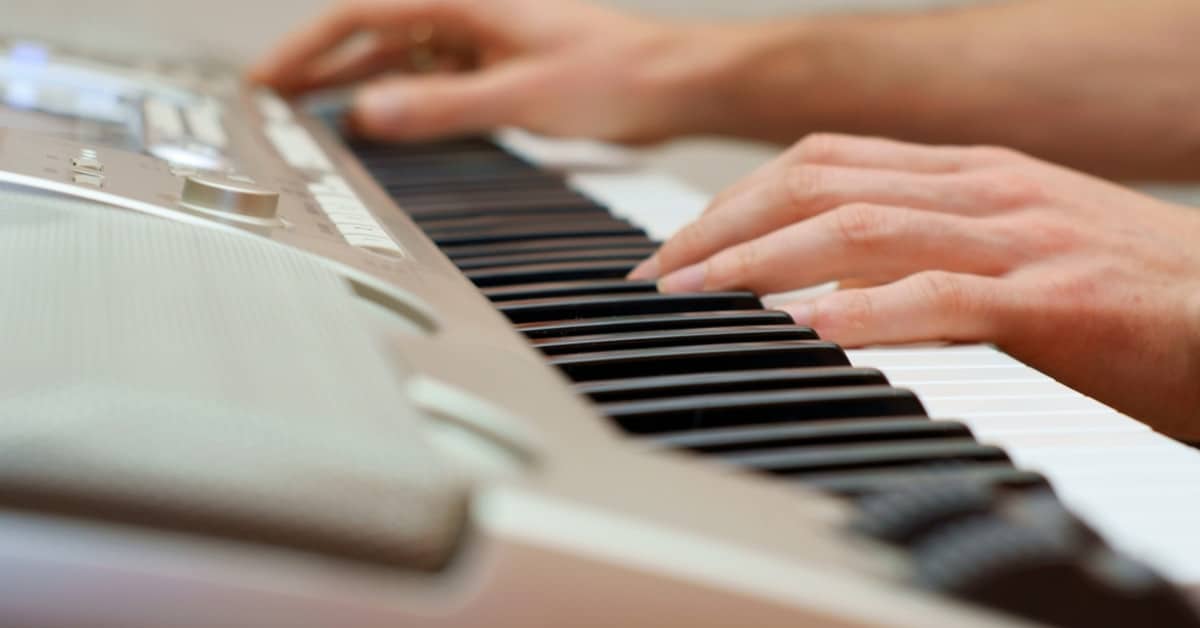The Piano Room function on the DGX-660 digital piano allows you to choose from a variety of great pianos and ambiances to personalize your piano sound (it even lets you adjust the lid). Sing along with your playing by plugging a microphone into the Yamaha DGX-660’s mic input.
The ultra-portable ES110, on the other hand, comes with the innovative Responsive Hammer Compact keyboard action, Harmonic Imaging 88-key piano sampling, and built-in Bluetooth connectivity to provide gig-friendly grand piano touch and tone at an amazingly low price.
Yamaha DGX 660
The Yamaha DGX-660 has 192-note polyphony, so even the most complicated arrangements will have enough voices. A footswitch can be connected and assigned to control numerous operations.
Wi-Fi (needs extra wireless adaptor, not included) is built into the arranger keyboard, allowing you to stream audio and MIDI to and from your iOS smartphone running Yamaha’s compatible apps.
Pros of Yamaha DGX 660
- Display: LCD
- Keyboard with 88 keys and hammer motion
- Yamaha CFIIIS Concert Grand Piano sounds were sampled.
- Songs, genres, rhythms, and sound effects are all available in a large collection.
- Capabilities for audio/MIDI recording
- Connectivity possibilities are many.
- Learner-friendly attributes
- It’s accompanied by a robust stand.
Pros of Yamaha DGX 660
- Massive
- It’s not as portable as its rivals.
- The headphone jack is located on the rear of the device.
- Sustain pedal that is simple.
Kawai ES110
The ES110’s Responsive Hammer Small keyboard action was created specifically to allow compact instruments to mimic the unique touch of an acoustic grand piano.
Its spring-less technology and sturdy construction, which are based on the well-known RH action design, deliver continuous upward and downward motion for the smoothest, most natural, and most authentic piano playing experience possible.
Pros of Kawai ES110
- Gig-friendly
- The RHC action is one of the best in its class since it is fully weighted.
- 19 built-in instrument sounds 192-note polyphony
- 106 preset tunes and 100 rhythms Wireless Bluetooth MIDI connectivity eight realistic piano tones sampled from the 9-foot EX Concert Grand 8 authentic piano tones captured from the 9-foot EX Concert Grand
- Sustain pedal with half-pedal assistance is included.
Cons of Kawai ES110
- There will be no display.
- Inconsistent spacing between the keys is a problem.
- MIDI recorder with only one track
- There are no USB ports.
| Yamaha DGX 660 | Kawai ES110 | |
| INPUTS | • 1 x 1/4″ Microphone Input • 1 x 1/8″ / 3.5 mm TRS Aux Input | 1/4″ L/MONO, R [unbalanced] |
| OUTPUTS | 1 x 1/4″ TRS Output | 2 x 1/4″ Stereo jacks |
| CONTROLS | • 88 Keys • Type Graded Hammer Standard(GHS) keyboard • Soft • Medium • Hard • Fixed | • 88 keys • Grade-weighted hammers • Matte key surfaces |
| CONNECTION TYPE | • 1 x USB Type-B (Computer Transfer) • 1 x USB Type-A (External Memory) | • MIDI IN • MIDI OUT • Bluetooth MIDI |
| MONITORING | ||
| COMPATIBILITY | • Windows • Mac | • Windows • Mac |
| SIZE | • 1,397mm (55”) /with keyboard stand 1,399mm (55-1/16”) • Height 146mm (5-3/4”) /with keyboard stand 761mm (29-15/16”) • Depth 445mm (17-1/2”) /with keyboard stand 445mm (17-1/2”) | • Width 131 cm (51 2/3″) • Depth 28.5 cm (11 1/4″) • Height 15 cm (6″) [music rest detached] |
| WEIGHT | 21kg (46 lbs. 5 oz.)/with keyboard stand:28kg (61 lbs. 12 oz.) | 12 kg (26 1/2 lbs.) |
| INCLUDED APPS | ||
| WARRANTY | 3 Year Part and Labor Warranty | 2-Year Warranty |
Comparison
The DGX-660 has a lot of features, almost too numerous to discuss. You get all of the typical features on a keyboard at this price point, such as recording, lessons, and well-weighted keys. You do, however, receive a nice LCD screen to teach you, as well as the ability to connect wirelessly with phones and tablets.
While on the other hand, the ES110 is a more inexpensive and portable grand Kawai model; it’s a plain-looking device with no displays or banks of switches, but it’s a great room for compromise.


